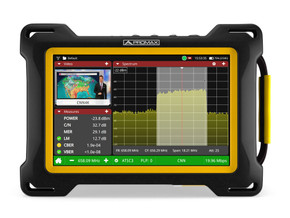

The PROMAX ATLaS NG Rack Multipurpose Spectrum and Broadcast Analyzer (Rack Version) is a feature-packed spectrum analyzer which covers the most stringent requirements for broadcast professionals, including DVB-S2x, ATSC 3.0, IPTV, Fiber optics, 3G-SDI, Transport stream ASI, Wi-Fi, and OTT.
Television standards (such as ATSC 3.0) push the frontiers of what technology is capable of. ATSC 3.0 makes use of OFDM and as many as four simultaneous PLPs (Physical Layer Pipes) at the physical layer, and modulation schemes up to 4096-QAM. DVB-S2x provides higher throughputs and current signal modulation schemes that only the most advanced broadcast analyzers can handle. Some additional technologies adopted by the latest television standards include: 64/128/256-APSK modulations; 5%, 10% and 15% reduced roll-off factors; improved filtering and carrier spacing; and channel bonding - ATLaS NG Rack is fully compatible with all of them.
The ATLaS NG Rack analyzer is capable of taking measurements up to 6 GHz, covering the S and C bands, where an increasing number of technologies are fiercely competing for bandwidth. Technologies using S and/or C band are: Satellite teleports, VSAT ground networks, Radar, Terrestrial microwave links, Broadband Wireless Access (BWA) networks (LTE, Wi-Max, 5G, etc.). A 6 GHz spectrum analyzer becomes vital to identifying and evaluating why systems and services are being disrupted by interferences.
The ATLaS NG Rack runs full 3G-SDI signal diagnosis, including a professional audio meter and eye diagram, and features an external SDI input for that task (other than the standard ASI input and output).
The omnipresence of IP technology in the broadcast industry makes it compulsory for an analyzer to be capable of feeding from IPTV signals and monitoring them. Therefore, it is essential to have a tester like the 3G-SDI that can monitor and picture IPTV streams.
Key Features






The PROMAX ATLaS NG Rack Multipurpose Spectrum and Broadcast Analyzer (Rack Version) is a feature-packed spectrum analyzer which covers the most stringent requirements for broadcast professionals, including DVB-S2x, ATSC 3.0, IPTV, Fiber optics, 3G-SDI, Transport stream ASI, Wi-Fi, and OTT.
Television standards (such as ATSC 3.0) push the frontiers of what technology is capable of. ATSC 3.0 makes use of OFDM and as many as four simultaneous PLPs (Physical Layer Pipes) at the physical layer, and modulation schemes up to 4096-QAM. DVB-S2x provides higher throughputs and current signal modulation schemes that only the most advanced broadcast analyzers can handle. Some additional technologies adopted by the latest television standards include: 64/128/256-APSK modulations; 5%, 10% and 15% reduced roll-off factors; improved filtering and carrier spacing; and channel bonding - ATLaS NG Rack is fully compatible with all of them.
The ATLaS NG Rack analyzer is capable of taking measurements up to 6 GHz, covering the S and C bands, where an increasing number of technologies are fiercely competing for bandwidth. Technologies using S and/or C band are: Satellite teleports, VSAT ground networks, Radar, Terrestrial microwave links, Broadband Wireless Access (BWA) networks (LTE, Wi-Max, 5G, etc.). A 6 GHz spectrum analyzer becomes vital to identifying and evaluating why systems and services are being disrupted by interferences.
The ATLaS NG Rack runs full 3G-SDI signal diagnosis, including a professional audio meter and eye diagram, and features an external SDI input for that task (other than the standard ASI input and output).
The omnipresence of IP technology in the broadcast industry makes it compulsory for an analyzer to be capable of feeding from IPTV signals and monitoring them. Therefore, it is essential to have a tester like the 3G-SDI that can monitor and picture IPTV streams.
Key Features